Imagine stepping into your car and it feels as fresh as the day you first bought it. That feeling is not just about looks. It is about comfort, pride, and care. A quick wash can remove dust, but it cannot bring back the deep shine or protect the surfaces for long. This is where car wash detailing makes the difference.

It is a careful process that cleans every part of your car, inside and out. The goal is to restore the look and protect it for the future. Think of it as a reset button for your car. In this guide, you will learn simple steps that anyone can follow. No tricky tools. No hard words. Just clear advice to keep your car clean, polished, and ready for the road.
Car Wash vs Car Detailing
Washing and detailing sound similar, but they are not the same.
- Washing is a quick clean. It removes dust, mud, and surface dirt. It makes the car look better for a short time.
- Detailing is a deep clean. It focuses on every part of the car, inside and outside. It clears hidden dirt, restores shine, and adds protection.
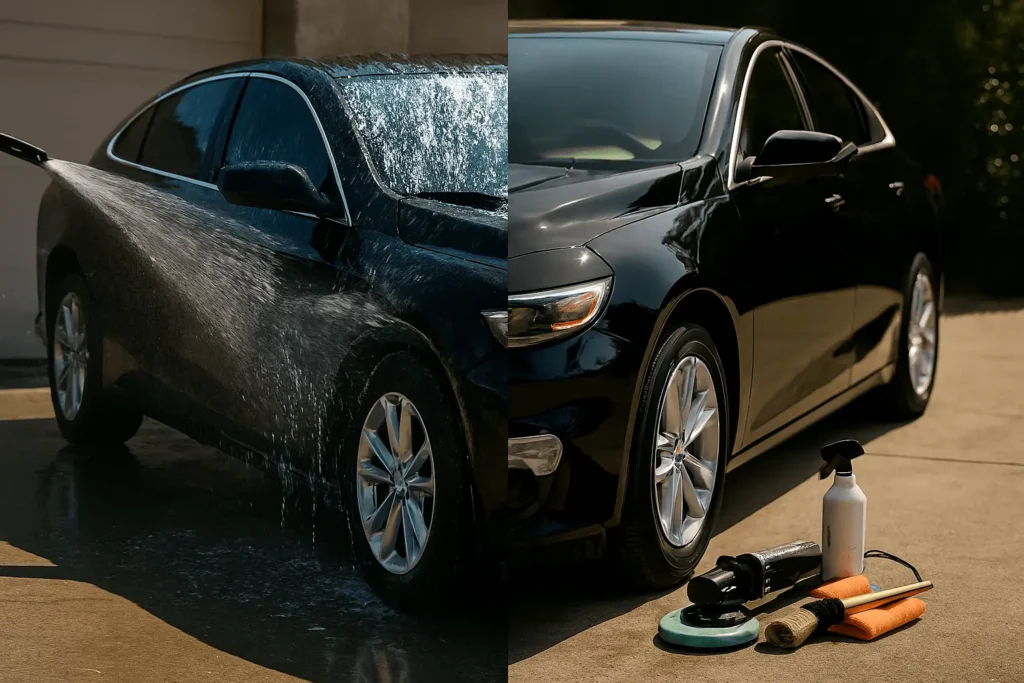
Think of washing as a simple shower. Detailing is like a full spa treatment. Both are useful, but detailing gives longer‑lasting results.
Why Detailing Matters
Detailing is more than making a car look nice. It helps it stay in good shape for years.
- Protects paint: Polishing and protective layers stop fading and scratches.
- Keeps the inside fresh: Clean seats, carpets, and vents prevent wear and bad smells.
- Prevents damage: Removing dirt and salt reduces rust and corrosion.
- Improves resale value: A well‑kept car looks newer and sells for a better price.
Regular care is like giving your car a shield. It stays cleaner, stronger, and ready for the road.
How to Detail Your Car at Home
Detailing at home may sound hard, but with the right steps it becomes simple. Follow this process to give your car a fresh, clean look without needing special skills.
Step 1: Prewash to remove heavy grime
Rinse the car with plenty of water. This loosens mud, dust, and road salt so they do not scratch the paint later.
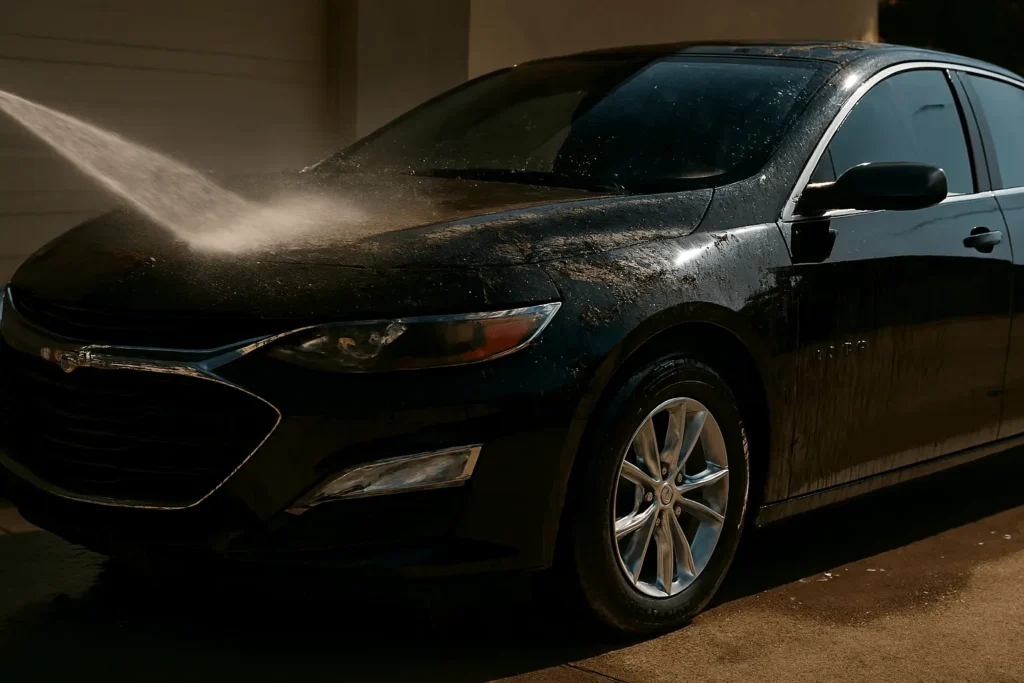
Step 2: Apply snow foam for softening dirt
Cover the car with foam and let it sit for a few minutes. The foam breaks down stuck dirt and makes cleaning easier.
Step 3: Deep clean with car shampoo
Use a soft sponge or wash mitt with shampoo. Work from top to bottom so dirt flows down and does not spread back.
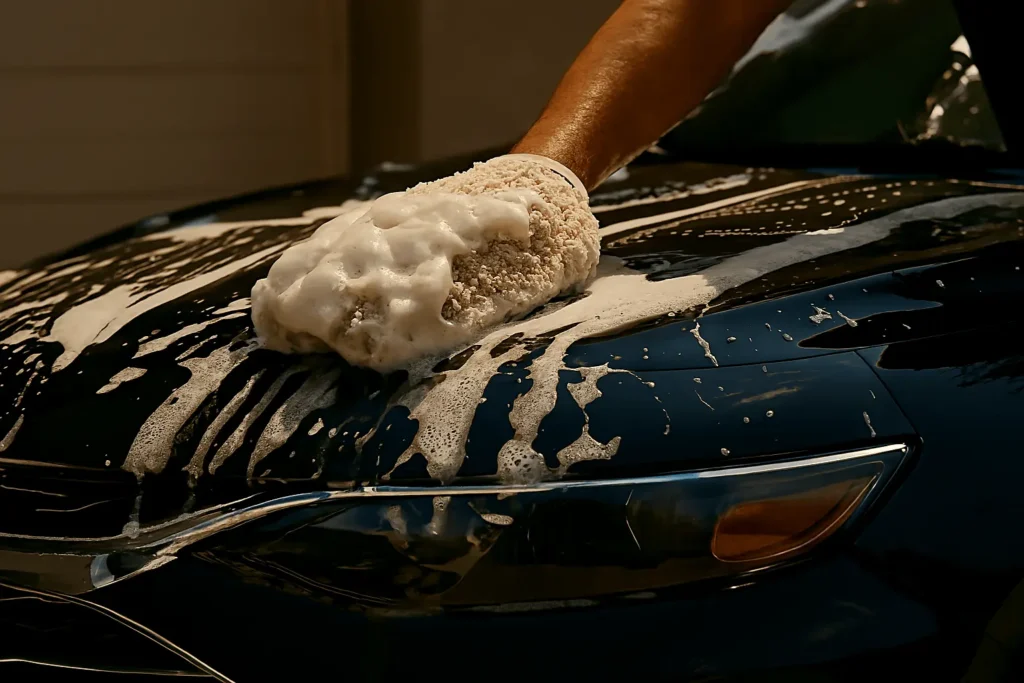
Step 4: Decontamination
Some stains stay put even after several washes.Use safe cleaners for tar or iron spots. A clay bar can lift tiny particles stuck on the paint.
Step 5: Drying your car safely
Use a clean microfiber towel. Pat the surface instead of rubbing to avoid scratches.
Step 6: Polishing for shine
Polish helps remove light marks and brings back a smooth finish. Work in small sections for the best result.
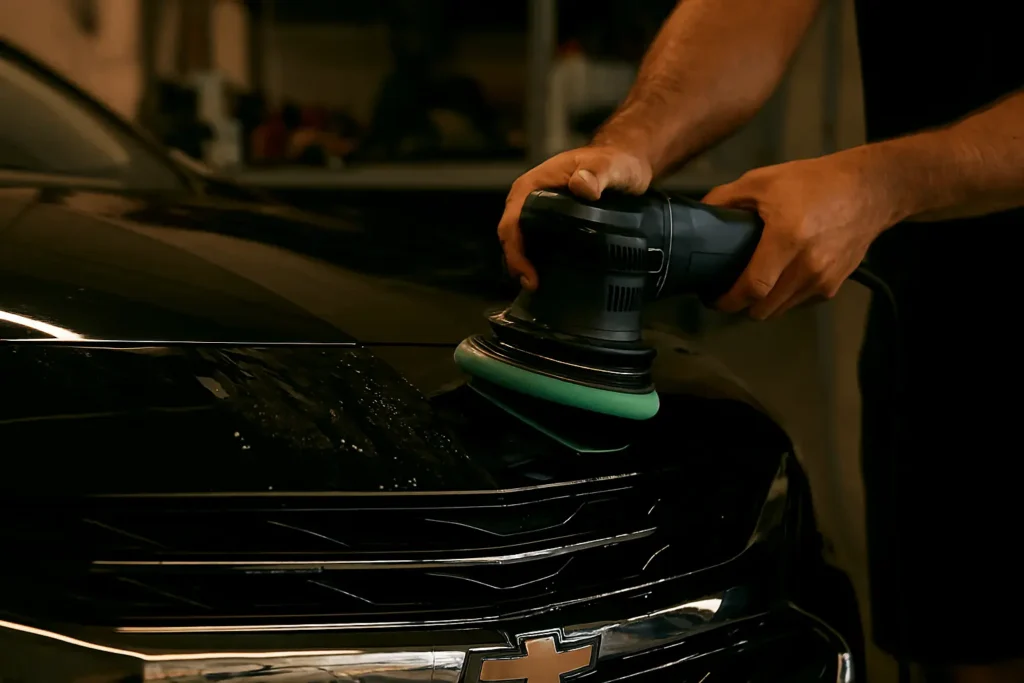
Step 7: Applying sealants or wax
Add a layer of protection with wax or sealant. This keeps the shine longer and shields the paint from weather.
Step 8: Cleaning tyres and trims
Scrub the tyres and plastic trims. A clean set of wheels makes the whole car look newer.
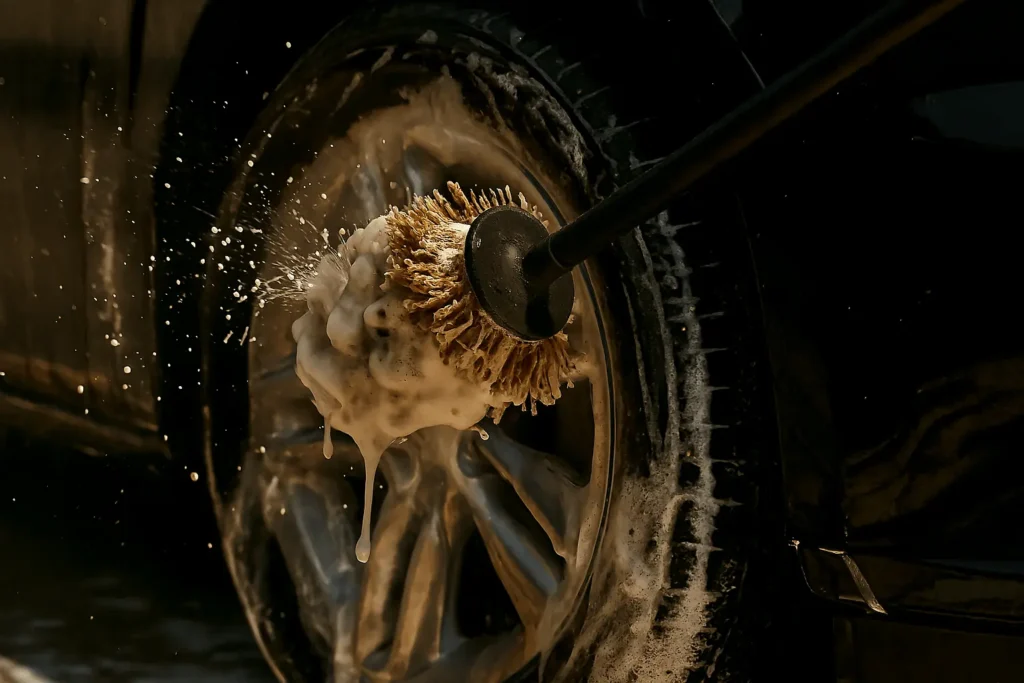
Step 9: Glass and mirrors
Use a glass cleaner for windows and mirrors. Clear glass improves both looks and safety.
Step 10: Quick detail spray for finishing touch
Finish with a light spray to boost shine and remove any leftover streaks.
How to Clean and Protect Your Car Interior
A clean inside makes driving more comfortable and keeps your car in good shape. Follow these steps to refresh and protect the interior.
Vacuuming & dust removal
Start by removing floor mats. Vacuum the seats, carpets, and corners where dirt collects. Use a small brush or nozzle to reach tight spaces like under the seats and between cushions. Wipe away dust from surfaces with a soft microfiber cloth.
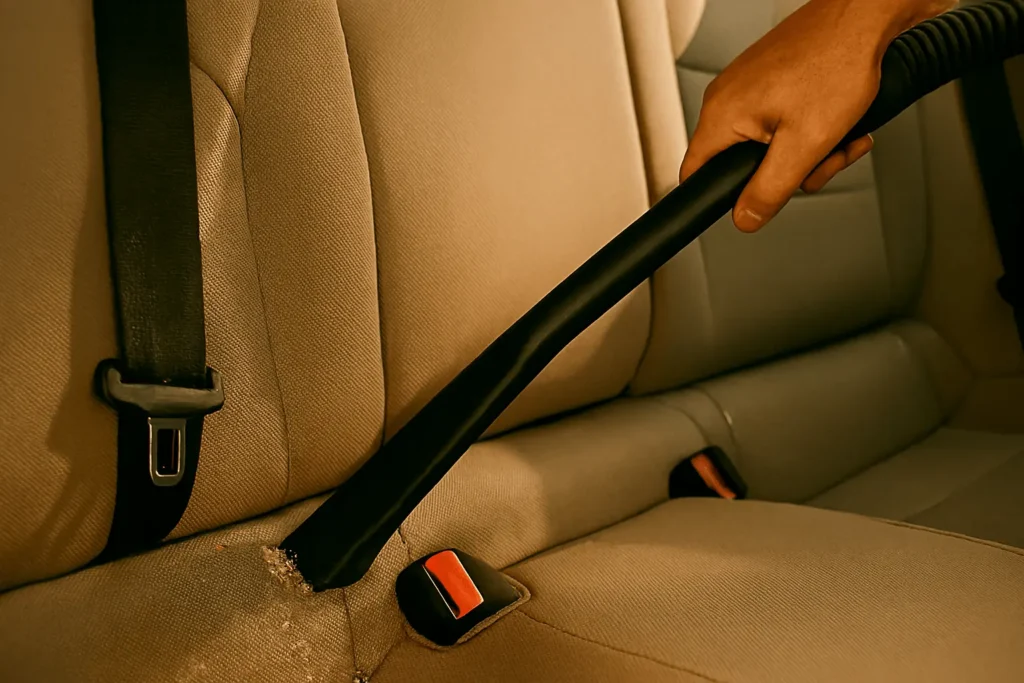
Upholstery & leather care
For fabric seats, use a gentle cleaner to remove stains. For leather, apply a leather conditioner to keep it soft and prevent cracks. Always test a small spot first to make sure the cleaner is safe.
Dashboard, vents & trims
The dashboard and air vents are favorite hiding places of dust. Use a soft brush or cloth to clean them. For trims and buttons, a damp cloth works well. Avoid using too much water so nothing seeps into the electronics.
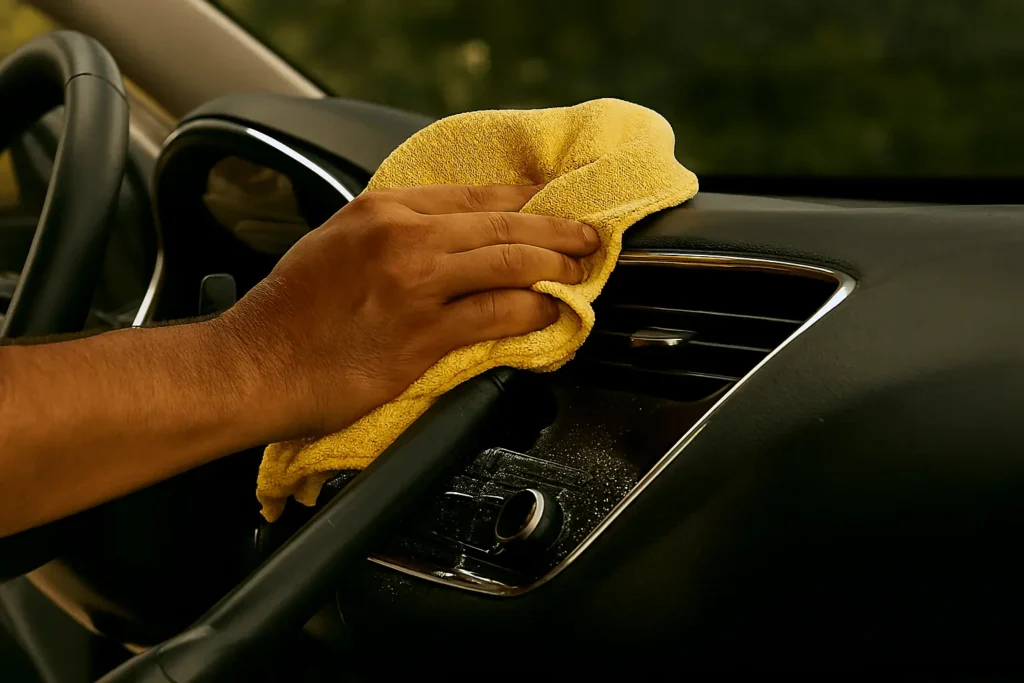
Odor removal & finishing touches
Bad smells often come from hidden dirt. After cleaning, use an air freshener or odor neutralizer. Place the mats back once they are dry. A final wipe with a clean cloth gives the interior a fresh look.
Must-Have Car Detailing Kit Essentials
If you want to care for your car at home, a good kit makes the job easier. You do not need dozens of products, just the right basics.
- Car shampoo: Gentle soap that cleans without harming the paint.
- Microfiber towels: Soft cloths that dry and wipe without scratching.
- Wash mitt or sponge: Helps spread shampoo evenly.
- Buckets: One for soapy water, one for rinsing, to keep dirt away.
- Clay bar: Removes tiny particles stuck on the surface.
- Polish: Restores shine and smoothness.
- Wax or sealant: Adds a layer of protection against sun and rain.
- Tyre and trim cleaner: Keeps rubber and plastic looking fresh.
- Glass cleaner: For clear windows and mirrors.
With these tools, you can handle most cleaning tasks at home without stress.
DIY Kits vs Professional Services
Both options have their place. The choice depends on your time, budget, and how much detail you want.
DIY Kits
- Cost less in the long run.
- Good for regular upkeep.
- Lets you work at your own pace.
- It just needs a little effort and regular practice.
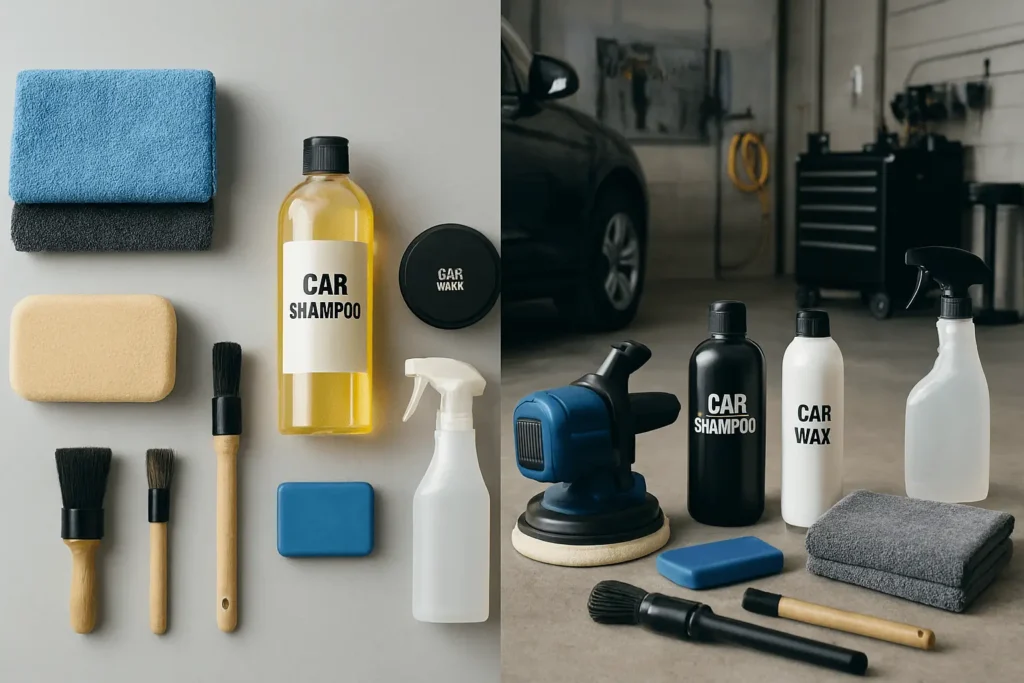
Professional Services
- Save time and energy.
- Experts handle tough stains and scratches.
- Often include advanced care like paint correction.
- A full package costs extra but offers more value.
When to Choose Professional Car Detailing
Sometimes doing it yourself is not enough. A professional service is the better choice when:
- Your car has deep scratches or faded paint. Experts can polish and restore the finish.
- The interior holds hidden stains or odors. Professionals have stronger tools and cleaners.
- You want to save time. A full detail at home can take hours, while a service handles it for you.
- You plan to sell your car. A detailed car looks newer and can increase its value.
If your car only needs light cleaning, a home kit works fine. But for heavy work or a showroom look, professionals are worth it.
Mobile Car Detailing
Mobile services bring the detail shop to you. Instead of driving to a location, the team comes with their tools and products.
Why people choose mobile detailing:
- Saves time by avoiding travel and waiting.
- Can be done at home, office, or even while you work.
- Offers the same deep cleaning as a shop.
- Great for busy schedules or families with more than one car.
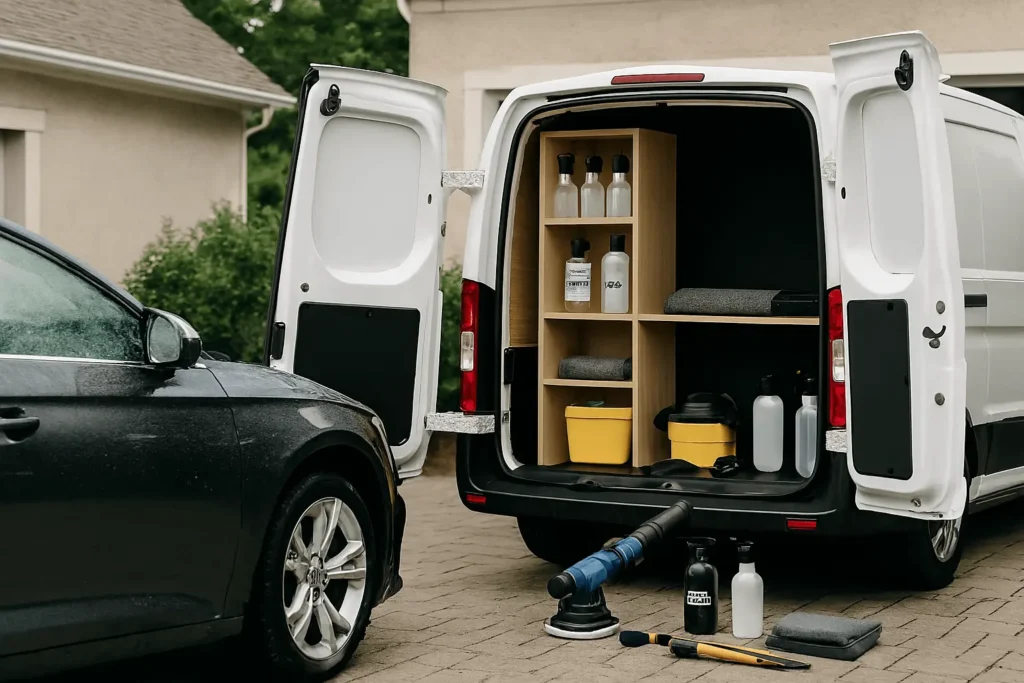
It is a simple way to keep your car fresh without changing your routine. For many, the convenience makes it the easiest option.
How Much Does Car Wash Detailing Cost?
The price depends on the size of the car, the type of service, and where you live. A small car usually costs less than a large SUV. Basic packages are cheaper, while full services with polishing and protection cost more. On average, you can expect:
- Basic clean: Lower price, covers outside wash and light interior care.
- Full detail: Higher price, includes deep cleaning inside and out.
- Premium add-ons: Extra cost for paint correction, odor removal, or special coatings.
Think of it like choosing a meal. A simple snack costs less, but a full dinner with extras will cost more.
How Often Should You Detail Your Car?
How often you detail depends on how you use your car. A car that stays in a garage needs less care than one that faces daily traffic, dust, or harsh weather.
General guide:
- Every 4-6 months: For most cars used daily.
- Every 3 months: If you drive in dusty, rainy, or salty conditions.
- Twice a year: For cars that are rarely used or kept indoors.
Regular care keeps your car looking fresh and helps protect it from long-term damage. It is easier to maintain than to fix problems later.
Paint Correction & Scratch Removal
Over time, small scratches and swirl marks make the paint look dull. Paint correction is the process of gently polishing the surface to remove these marks. It does not mean repainting the car. Instead, it smooths out the clear layer on top so light reflects evenly again.
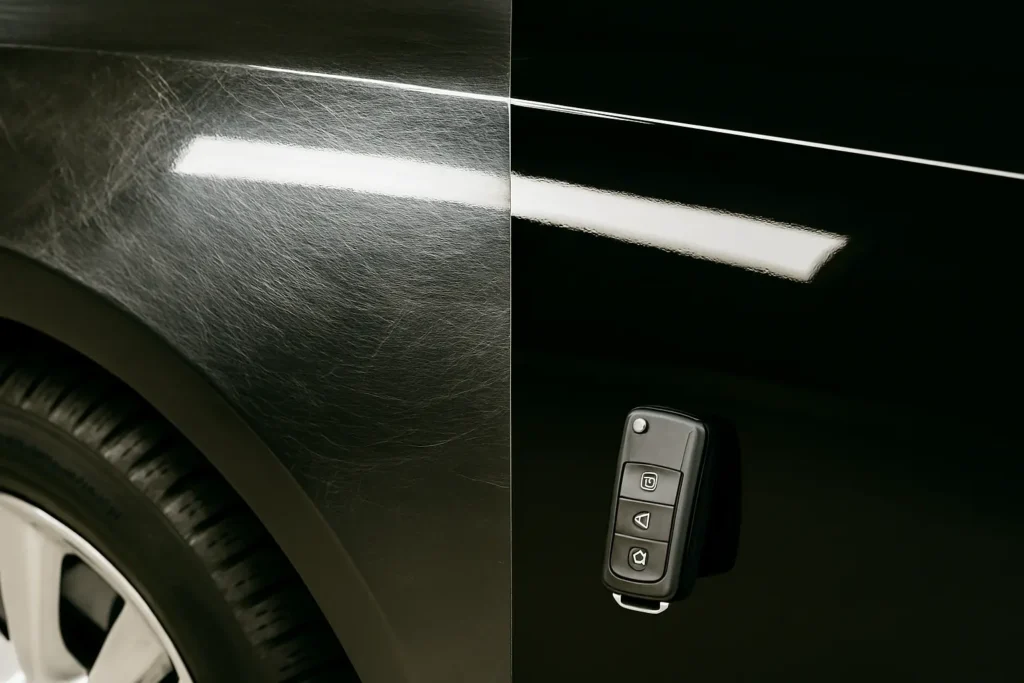
Why it matters:
- Restores shine and gloss.
- Removes light scratches and swirl marks.
- Makes the car look newer and well cared for.
For deeper scratches, professionals may need special tools. But for light marks, careful polishing at home can make a big difference.
Undercarriage Wash & Protection
The undercarriage is the bottom part of the car that faces the road. Without regular cleaning, mud and salt can trap moisture and lead to corrosion. Cleaning this area is just as important as washing the outside.
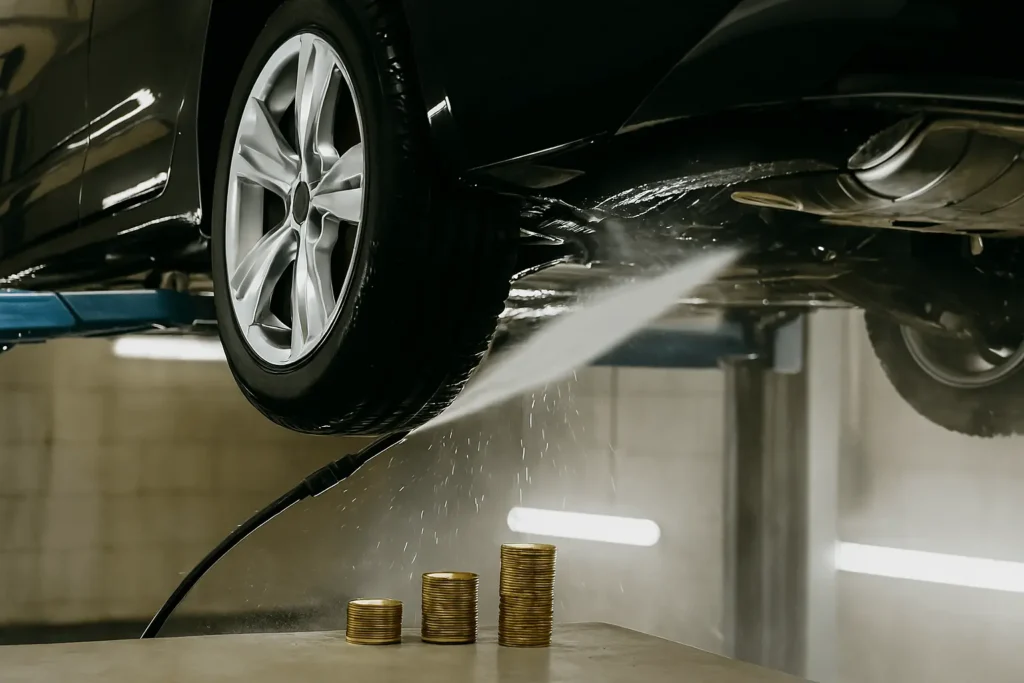
Steps to protect it:
- Rinse the underside with water to remove dirt and salt.
- Use a safe cleaner if there is heavy buildup.
- Dry the area to prevent moisture from sitting.
- Apply a protective coating to reduce rust and damage.
A clean undercarriage keeps the car strong and safe for longer, especially if you drive in rainy or salty conditions.
What is detailing in a car wash?
Car detailing means giving your car a deep, careful clean inside and out. It is more than just soap and water. It includes cleaning every small spot, polishing the paint, and making your car look fresh again.
What is a full detail car wash?
A full detail car wash is a complete cleaning service for both the inside and outside of your car. It includes washing, polishing, vacuuming, and restoring shine so your car looks almost brand new.
What is the difference between car washing and car detailing?
A car wash cleans the outside and gives a quick fresh look. Car detailing goes deeper, it cleans every corner inside and out, removes stains, and makes the car look like it just came from the showroom.
Does car detailing remove scratches?
Detailing can fade light scratches and make them less visible. But deep scratches that cut into the paint usually need extra repair or polishing to fully remove them.
